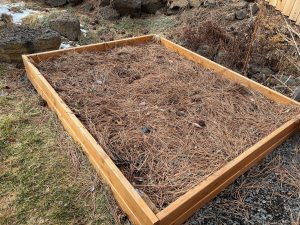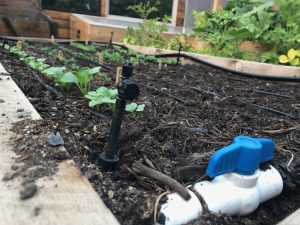Bend Urban Gardens one of the High Desert Food and Farm Alliance’s excellent business partners put together this guide to getting your garden ready for the season. Our cold Central Oregon climate requires people to take special measures to prepare their gardens. If you are new to gardening or looking to update your yard Bend Urban Gardens has many tips to get you on the right track.
No matter where you’re at in your Central Oregon veggie gardening adventure, there are four things every gardener can do to prepare for the start of a new growing season:


1. Irrigation
Invest in tools to help you water your garden! Are you thinking that hand-watering your garden will be a great way to include a peaceful, meditative routine into your life? It might! But, from our experience, the benefit of hand watering is really that it requires you to slow down, which often results in you observing your plants and noticing how they are doing in a way you might not see otherwise. Hand watering gets old pretty quickly for most gardeners, though. Plus, it really isn’t the most effective way to water your veggies. At this point in time, drip irrigation is the most efficient irrigation technology we have for watering vegetables. The City of Bend is even offering a rebate program to help you save water and money and switch to drip!
By using drip, you can control how much water is being applied to your garden. Ideally you’ll have an irrigation zone solely for your annual veggies, another for native plants that you’re getting established, and another for edible perennials, for example, even if they are all on drip. These plants have differing water needs and these separate zones will help you use water most efficiently and give everyone what they need.
If you don’t have any additional zones available on your automated irrigation system, and don’t want to invest in creating more quite yet, you could temporarily set up a hose bib timer for your vegetable garden. Detach the timer after each use to prevent frost damage in the spring.
You may need to hand water for a short time to get good germination for direct sown crops or if it’s still a bit too early in the season to turn your irrigation system back on. Installing drip irrigation typically makes gardening much more enjoyable than hand watering for most people, though!
If you have a large garden, consider adding adjustable microsprayers to your drip set-up just to promote good germination for direct sown crops and then switch to your drip line with in-line emitters once you have seedlings.
2. Soil
If you’ll be installing a new garden in large containers or raised garden beds, fill them with a high quality mix. Purchasing a raised bed mix in bulk will likely be the most economical. Be sure to inquire about the inputs that go into the mix. Are they tested for contaminants? If bulk soil isn’t an option for you and you’ll be creating a mix from bagged products, we recommend 60% soilless raised bed mix, 20% topsoil, and 20% compost. If you’ll be growing in smaller containers, filling or replacing soil from last season, a soilless medium is a good, lightweight choice, although a lot of gardeners are now trying to avoid peat moss because of an increased awareness of the environmental consequences of mining peat. For more details about soil recommendations, check out our blog post on filling raised beds with soil. For newer gardens, we also recommend applying a balanced organic fertilizer, following the manufacturer’s application instructions of course!
If you already have established raised beds and didn’t mulch them with compost in the fall, consider getting a soil test to inform how to best amend your soil this season. If you’re going to forego soil testing, our general recommendation is to mix in 1/4” – 1/2” of compost before planting. Then, wait until your soil temperature is consistently 45 degrees and you can start sowing seeds and transplanting the most cold hardy plants.
3. Crop Planning
Water and soil are just two variables that greatly impact the health of plants. Instead of cramming as many plants into your space as possible, we strongly recommend creating a detailed crop plan to use as a guide throughout the season. This will help you maximize your space, while still spacing plants appropriately, along with prioritizing the diverse crops you’d like to grow and shopping for short season varieties. A crop plan can also help you stay on track for meeting your gardening goals by helping you make an indoor seed starting calendar (if you’ll be transplanting plants you start on your own from seed) and help you log your planting and harvest dates, better familiarizing yourself with your unique microclimate. Plus, knowing how many plants you need and when you need them will help you minimize your impulse plant and seed packet buys and save money, too. We can help you create a comprehensive crop plan to use as a framework for seasons to come.
4. Season Extension Tools
While we don’t have any official last frost dates in Central Oregon since we can get frost any day of the year, using a mini hoophouse to warm up your soil in the spring typically means that plantings of cold hardy crops can go in around April 15th, when the soil temperature is consistently 45 degrees (use a soil thermometer). This can make all the difference in allowing you to plant a succession of leafy greens, for example, before you get your cold sensitive plants in the same location in June.

If you don’t use season extension to warm up your soil, May is more realistic for your first plantings of the season. Row cover/frost cloth and low hoops could help to warm up your soil a little bit, but they won’t retain as much heat as a greenhouse environment. Sometimes double covering your plants with row cover and greenhouse plastic is needed to promote more continuous day/night growth by keeping your growing environment above 50 degrees. Wait until June to transplant heat loving crops (tomatoes, basil, peppers, & cucumbers, etc. ) and consider using walls of water / “season starters” to protect them from cold temperatures if not using mini hoophouses. If you’re growing your own plant starts, though, be prepared with back up plants and don’t be afraid to plant earlier and replant if needed!










